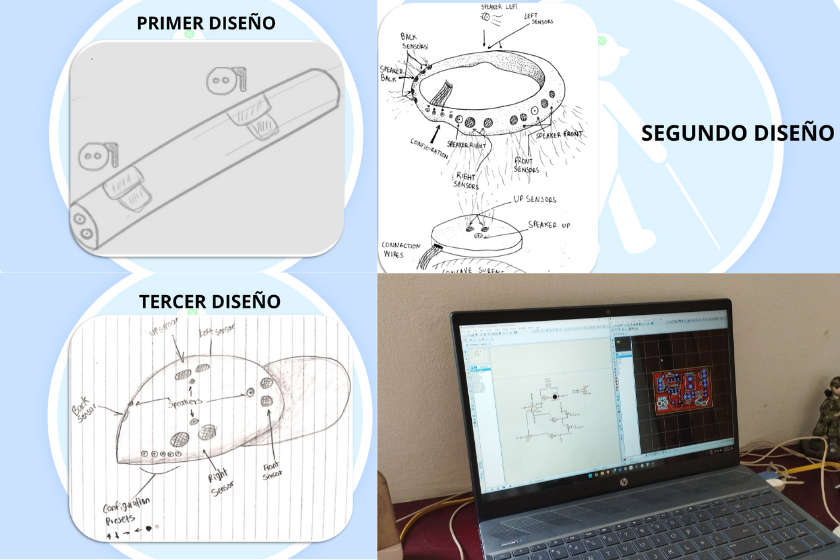One difficulty that people with visual impairments find in everyday life is that many environments are not designed to be inclusive. There are not always signs, such as tactile floors, to help with orientation, or spaces for moving around free of obstacles. As a result, there is a high risk of being hit, especially in the head and upper body. With this problem in mind, Colombian students created the “Eye Buzzer”; a device that warns when there are barriers ahead. The creation was one of the highlighted projects of Solve for Tomorrow 2023 in the country.
The prototype is basically a cap with sensors in five directions, alerting the user about sudden obstacles with the use of vibrators. It is also possible to have sound alerts, activating a speaker with a switch. In addition, the distance at which the sensors identify obstacles can be regulated, from 2 cm to 1 m.
The three students on the team were studying at the Technical Dámaso Zapata Educational Institution in the municipality of Bucaramanga and were 16 years old when they applied for Solve for Tomorrow and worked on this project from 9th to 11th grade, the last year of compulsory schooling. The mediator teacher, Lina Delgado, teaches Political Science and Economics, which combines citizenship, environmental problems and reality lessons. In addition, Delgado also teaches innovation and development, where students at the school learn the basics of scientific research from preschool.
Throughout the course, student groups, that they call companies, are formed to innovate together. “The students decide which projects they will do. Sometimes they even continue developing them into university.” “Eye Buzzer” is one of the 7 prototypes the “Deblind Caps” team made.
Discussions inside and outside the classroom lead to the prototype
The classroom methodology includes games to learn about the United Nations Sustainable Development Goals (SDG). “We observe the global scenario, in a transversal way that has to do with their lives, interests and pains,” she emphasizes. The teacher believes that project-based learning broadens the future perspective of young people and shows the importance of continuing to study. “It is wonderful to learn with the students. The projects are also an excellent opportunity to recognize their realities and help them have more self-esteem: they can realize that they are capable of changing the world,” she says.
One issue that caught the team’s attention was accessibility for people with visual disabilities, after a cousin of a student mentioned that she was going to teach Braille. “She invited them to talk with teachers who give these classes and inclusion professionals from the Department of Education of Bucaramanga,” she recalls. They then delved deeper into the problem, looking for data at global, national, and regional levels.
Thus, they saw that there was a problem of upper body injuries suffered by this population. They brought this up in the “Community of Inquiry”, a space in the classroom where someone presents an idea and everyone asks questions. And at the same time, they continued researching in articles and scientific journals that tried to solve the same problem.
They then decided to create a mechanism that would detect and warn when a barrier was nearby. The idea was that it would be something that could be placed on the head, which is an area more vulnerable to impacts. The first stage was to test an automated system that would allow this.
With further research, they arrived at a low-cost and functional formula. The programming was done with Arduino, an open-source electronic prototyping board. In addition, they needed Raspberry sensors, which are multi-platform single-board minicomputers and have a lower cost (depending on the model, the sensors can cost less than 40 US dollars). “The design and programming are done by the students. It’s very different from buying imported technology that you have to pay a patent for,” she compares. They tested everything in class and the theories were validated in practice. The device worked: the sensors that indicated obstacles and the vibration and sound alerts were well connected.
With these projects, we are teaching them to learn from mistakes. We say that you should always have a plan B, says Delgado.

A new vision of inclusion is born
To validate the prototype, the Universidad Pontificia Bolivariana was an ally. They participated in an event at the institution where they presented the project and a student with a visual disability offered to test the prototype. “He fell in love with the project and made some suggestions for improvement for the future, such as integrating a cane and installing a georeferencing system,” she describes. Later, they had the opportunity to test it in other institutions and fairs with more people with visual disabilities.
The teacher felt that the experience taught the students to communicate effectively, whether in the production of the video or the final presentation. “They do everything themselves, with the tools they have and in their own language,” she says proudly.
The project mentors helped the educator with materials that she continues to use in class, such as Design Thinking, a methodology for developing answers or solutions to complex questions or problems. “They gave us work tools that I share with my classmates. It’s very practical and good knowledge,” she says. Now, the young people are at university, studying Electronics and Biomedicine, but they are still interested in working on the project when they have free time.




